|
|

|
Rajasthan
is heaven for wide variety of wild animals and birds. The topography of
Rajasthan ranges from the barren desert, scrub-thorn arid forests, rocks
and ravines to wetlands and lush, green forests. Each of these areas
houses a large variety of animal and bird life. During the
Wildlife with Rajasthan Tour we visit various wildlife sanctuaries of
Rajasthan and North India. In this tour we visit the Corbett National
Park, Ranthambore National Park, Bharatpur Bird Sanctuary, Kumbhalgarh
Wildlife Sanctuary and Mount Abu Wildlife Sanctuary. In this tour
besides various wildlife sanctuaries we also visit various heritage
places of Rajasthan like Bhandarej, Jaipur, Shekhawati, Bikaner,
Jaisalmer, Jodhpur, Rohetgarh, Ranakpur, Kumbhalgarh, Mount Abu and
Udaipur and as well as Delhi and Agra.
|
|
|
|
Day 01: Delhi
Around midnight arrive in
Delhi. The cosmopolitan City and capital New Delhi is the main gateway for travelers. Upon arrival, you will be met by an Indo Vacations representative and transferred to the Hotel.
Day 02: Delhi – Corbett (about 296 kms / 6 hours)
In the morning we will drive to the
Corbett National Park. This park was established in 1936. It is the India's first National Park, and designated a Project Tiger Reserve in the year 1973. This park is known not only for its rich and varied wildlife but also for its scenic beauty. This park has Tigers, Leopards, Sambars, Chital, Hog Deer, Porcupine, Wild Pigs and Fox. The park has around 600 species of bird life.
Day 3: Corbett
Today in the morning after having the breakfast we will visit the Corbett
National Park on an elephant.
Day 4: Corbett – Agra (about 420 kms / 8 hours)
Today we drive to
Agra. Arrival in Agra in the late evening.
Day 5: Agra
We start today our sightseeing by a visit to the
Agra Fort, built by three of the greatest Mughal emperors. The construction of this massive structure began in 1565 under Akbar's reign and continued till the time of his grandson's reign, Shah Jahan who built the impressive imperial quarters and mosque.
After the visit of Agra Fort we
proceed to visit the most beautiful monument of
India, the
Taj Mahal, an
enduring monument to love, with a continually fulfilling beauty. It was built by
the Mughal Emperor Shah Jahan between 1631-52, as a tomb and memorial to his
beloved wife Mumtaz Mahal (Jewel of the Palace), who died at the age of 39
giving birth to her 14th child. Rest of the day our driver and car
is at your disposal to visit some more monuments as per your personal wish like
Itmadullah and famous marble temple which is being constructed since many decades but still uncompleted.
|
|
|
|
|
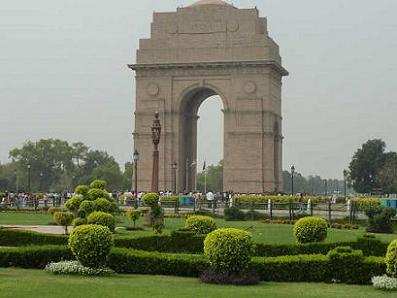 |
 |
|
India
Gate, Delhi |
Taj
Mahal, Agra |
|
|
|
Day 6: Agra – Bharatpur (about 56 kms / 1 hour)
In the morning we drive through a series of fields, small towns and villages in direction of Bharatpur. Enroute we make a stop and visit
Fatehpur Sikri, which was once an imperial capital frozen in time, constructed by Akbar the Great in the 16th century. This wonderful city constructed by red sand stones was abandoned as abruptly as it had been built. It has been generally stated that it was due to failing in the water. After visiting Fatehpur Sikri we drive to
Bharatpur. Bharatpur has its fame due to Keoladeo Birds National Park. Bharatpur was earlier a duck shooting resort of the Maharaja. Keoladeo National Park with its 375 species is one of the best Water Birds Sanctuary in the world. In winter there are many migratory birds from the northern hemisphere including the rare Siberian crane.
Day 7: Bharatpur – Bhandarej (about 110 kms / 2½ hours)
Today in the morning we visit the
Bharatpur
Bird Sanctuary or Keoladeo Bird National Park. After visiting the park we leave Bharatpur and arrive at the palace Hotel of
Bhandarej which has a blend of Mughal and Rajputana
architecture.
The Bhadrawati Palace is a Heritage Property with a fascinating History. Tracing back to 11th Century, when the Kachhawaha Chieftain Dhula Rao Saheb defeated the Badgujars and conquered Bhandarej. The Palace is splendidly restored and refurbished to the former glory. The Bhandarej palace has courtyards, arched windows, traditionally painted verandahs and front lawns. The nearby
Bhangarh
village with its temples and historical sites has a history which dates back to
11th century. Rest of the day at leisure. At the dinner time local dances will
be performed in the palace.
Day 8: Bhandarej – Ranthambore (about 115 kms / 2½ hours)
Today after the breakfast we leave for
Ranthambore.
Ranthambore is known for the world famous Ranthambore National
park. After a break and refreshment at our hotel in Ranthambore we will explore
the
Ranthambore National park on a Jeep. Ranthambore National Park is surrounded by the Vindhyas and
the
Aravali mountains and covers an area of 392 square km. The Tiger remains the
biggest attraction of the Ranthambore National Park.
Day 9: Ranthambore
In the early morning we again explore the park on jeeps. If we are lucky enough
we might have an audience with the tiger which are numerous in the park.
Day 10: Ranthambore – Jaipur (about 195 kms / 4 hours)
Today we drive to the Pink City,
Jaipur. This city owes its name, foundations and careful planning to the great warrior and astronomer, Maharaja Sawai Jai Singh II. Jaipur is the capital of Rajasthan and famous for its
handicrafts and precious and semiprecious stones. In the afternoon we visit the
City palace which is still the formal residence of the royal family, built in a blend of the Rajasthani and Mughal architecture. In the museum of the city palace we visit the private collection of the Jaipur Maharajas. We continue to
Jantar Mantar,
a stone observatory, the largest of Jai Singh's five remarkable
observatories. Its complex instruments reveals us the secrets of
medieval Indian astronomy. |
|
|
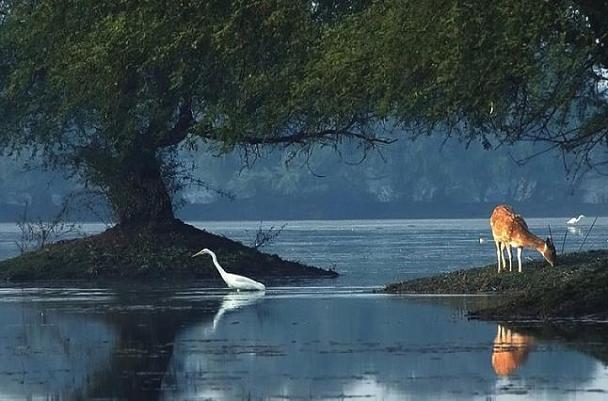 |
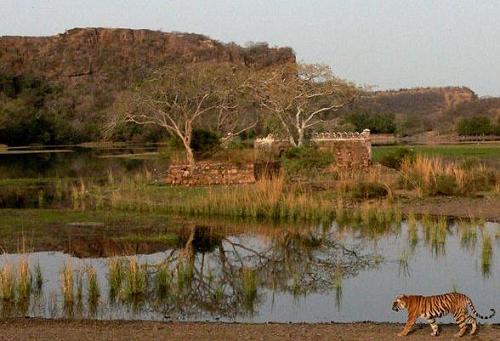 |
|
Bharatpur Bird Sanctuary |
Ranthambore National Park |
|
|
|
Day 11: Jaipur
After breakfast we drive to the ancient capital of
Amber, laying 11 km away from Jaipur. Amber was the ancient capital of Kachhawaha dynasty for 6 centuries before it was moved to newly created Jaipur. We will ascend to the Palace Fortress on the back of an Elephant. Enroute to Amber we visit the
Hawa Mahal (Palace of the Winds), built in 1799 AD, it contains 953 small casements with each having its own balcony. The windows enabled cool air to circulate and the ladies to watch processions below without being seen. In the afternoon we have a walk through the colourful Bazaar of Jaipur and visit a factory to see the famous block printing work being done since centuries in Jaipur. In the evening we drive through the new city of Jaipur and visit "Laxmi Narayan Mandir", a Hindu temple made out of white marble. We might have an opportunity here to observe a prayer ceremony. Today we have dinner with a presentation of Indian music and dance.
Day 12: Jaipur
The whole day at leisure in Jaipur. Today we would like to invite you to visit an Indian family and have a cup of tea with them while watching the Indian food cooked just in front of you. You can learn to use the
Indian spices and the some of the secrets of Indian cooking from the house lady. You also have an opportunity today to meet an Ayurveda doctor and we also offer you an Ayurveda Massage by the expert. You will learn how to use the right oil for body massage as well as some more information will be provided on Ayurveda by our experts.
Day 13: Jaipur – Shekhawati (about 168 kms / 3½ hours)
Today we drive to
Shekhawati region. Arrival in Shekhawati in the late afternoon. Have a walk in the old city of
Shekhawati. Shekhawati lies in north east region of
Rajasthan
and is the homeland of marwaris. The marwaris form one of the most important merchant and business groups in
India. They developed their business acumen on the trade routes between Delhi and the coast between India and Central Asia. The marwaris enjoyed protections by Maharajas and many of them built grand havellis. The havelis are mansions, elaborately and attractively decorated with a strong main entrance. The walls are often covered with murals, local legends and religious scenes from
Hindu Mythology.
Day 14: Shekhawati
In the morning we visit the grand havellis of the Shekhawati area.
Today we also have an excursion of
Lachmangarh and Nawalgarh Area. The Fort of Lachmangarh which is one of the most impressive fort in Shekhawati area. It is worth going up to the top to get a view of the town below. The town planning seems similar as Jaipur, the capital city of Rajasthan.
After visiting the Lachmangarh area we drive to
Nawalgarh. Nawalgarh was a central point for many of the trader families who decorated their havellis with the fresco paintings. Some of them are Poddar Haveli, Roop Niwas, Saat Haveli. One can also visit a few temples and the fort of Nawalgarh. Our driver will take you the places where most of the tourists have not been.
|
|
|
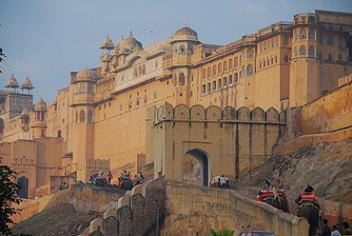 |
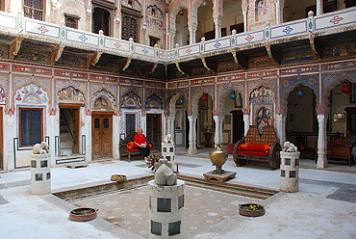 |
|
Amber
Fort Jaipur |
Mandawa Haveli |
|
|
|
|
Day 15: Shekhawati – Bikaner (about 190 kms / 4 hours)
Today we drive to
Bikaner. After a short break in Bikaner we visit the
Junagarh Fort (1571-1611 AD) constructed of red sandstone and marble with kiosks and balconies embellishing the structure at intervals. This imposing Fort and its palaces are an unforgettable experience. In the evening visit a camel farm which is unique of its kind in Asia and we have an explanation from the local Guide about the different breeds and behavior of male and female camel and their life style.
Day 16: Bikaner
Today we have a
Camel Safari and enjoy the stay in tent with all the basic facility. You will be accompanied by our safari experts.
Today you will be
served the food in the desert.
Day 17: Bikaner
Today also we have a camel safari and enjoy the stay in the tent. Today your
dinner will be served under the open sky with the candle light.
(Optional:
Excursion to
Gajner Wildlife Sanctuary. Various animals can be seen in this
sanctuary like Nilgai, Chinkara and Blackbuck. On the banks of the lake stands
the royal summer palace.)
Day 18: Bikaner - Jaisalmer (about 330 kms / 6-7 hours)
In the early morning we again have camel safari and then leave for
Jaisalmer.
Enroute we just drive for 30 kms. from Bikaner to Deshnok village and visit the famous
Karni Mata temple, the famous rat temple. Very often one can see along the road to Jaisalmer some of the antelopes of this region. Blackbuck and fast running chinkara are the most common among them. We have a stop enroute at a village to observe the traditional life of the villages in Rajasthan. We arrive in Jaisalmer in the late evening.
Day 19: Jaisalmer
Today we have sightseeing of the medieval city of Jaisalmer. Jaisalmer's crenellated golden sandstone walls and its narrow streets lined with exquisitely carved buildings make this city unique. Jaisalmer is famous for its carved
Havelis (grand mansions). In medieval times, its prosperity was due to its location on the main trade route linking India to Egypt, Arabia, Africa and the West. Jaisalmer is a marvel of beautiful culture and this city remains one of the most exotic city not only in Rajasthan but in the whole of India. Some of the visitors called this city "a living museum". We have a walk through the old city and visit the
Fort and the
Jain temple. In the afternoon we drive around 40 km. away from Jaisalmer to
Sam dunes or Khuri dunes where we enjoy the sunset before we drive back to Jaisalmer.
|
|
|
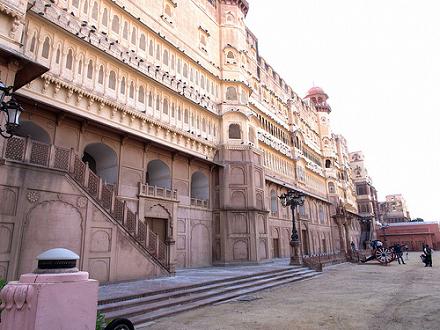 |
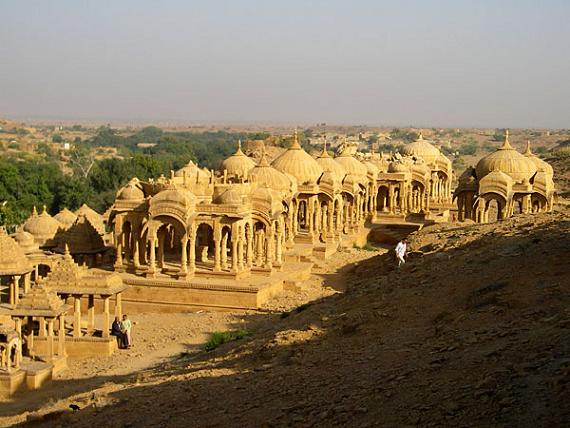 |
|
Juangarh Bikaner |
Bada
Bagh Jaisalmer |
|
|
|
Day 20: Jaisalmer – Osian - Jodhpur (about 290 kms / 6-7 hours)
Early morning drive to
Jodhpur via Osian.
Osian
is a great centre of Hindu and Jain religions. The oldest Temple here was
constructed in 1178 AD. After visiting the temple we proceed further to Jodhpur.
Jodhpur was once the capital of the princely state of Marwar (Land of death).
Jodhpur is the second largest city in Rajasthan. Jodhpur is also known as the
blue city as most of the houses of the old city are painted blue. The old city
is surrounded by a huge 10 km long wall which has 101 bastions and seven gates. We will visit the
Mehrangarh Fort (majestic fort). Mehrangarh Fort was built on a steep hill and is among the best in India with exquisitely latticed windows in residential apartments within. We also visit the
Jaswant Thada, a royal cenotaph built in white marble. After the sightseeing we have a walk through the Bazaars of Jodhpur which is considered one of the most traditional one in Rajasthan.
Day 21: Jodhpur – Rohetgarh (about 50 kms / 1 hour)
Today we take leave from Jodhpur and drive to Rohetgarh.
Rohetgarh
is famous for its fort of 17th century which is now a luxury heritage hotel. We will be welcomed by the royal family personally. We are invited to relax in spacious varandah lounges decorated with historic trophies or we can relax at the beautifully designed swimming pool. Around Rohetgarh there are Bishnoi villages. We will enjoy Jeep Safari to
Bishnoi village. Bishnoi tribes have made environmental and wildlife protection in their religion in the 15th century and enjoy great respect among other tribes of Rajasthan.
Day 22: Rohetgarh – Ranakpur (about 150 kms / 3 hours)
Today we drive to
Ranakpur. Ranakpur is known for its superbly carved marble Jain Temples. An enormous basement of this temple covers 48,000 sq. feet. There are four subsidiary shrines, twenty four pillared halls. The total number of columns is 1444, all of which are intricately carved, no two being alike. The Ranakpur Jain Temples were built during the 15th century.
Today we have one night stay in Ranakpur and visit the
Ranakpur Jain temples and also discover this small village on foot which is at the same time one of the holiest and pilgrimage place for the
Jains.
Day 23: Ranakpur – Kumbhalgarh (about 48 kms / 1 hour)
Today we drive to
Kumbhalgarh. Late evening we arrive in Kumbhalgarh. Kumbhalgarh is one of the finest examples of defensive fortification in Rajasthan. The main tourist attraction of Kumbhalgarh is the Kumbhalgarh Fort.
|
|
|
 |
 |
|
Mehrangarh Fort |
Adinatha Tempel in Ranakpur |
|
|
|
|
Day 24: Kumbhalgarh
Today visit the
Kumbhalgarh fort. This fort was the second most important fort of the Mewar kingdom after
Chittorgarh. This fort is rising from a prominent ridge at a height of 1914 meters high from the sea level. The fort was built in 15th century AD by Rana Kumbha. The fort has witnessed many heroic deeds of great warriors.
We also drive to
Kumbhalgarh wildlife sanctuary which has an area of 578 sq kms and is situated at the height of 500 to 1,300m. There are wolf, leopards, sloth bear, hyena, jackal, jungle cat, sambhar, nilgai, Chausingha (the four horned antelope), chinkara and hare are found at the century. For Bird lovers there are also a lot to admire, jungle fowl can be spotted here. Peacocks and Doves can be seen very often. Your safari route starts from the sanctuary from the Kumbhalgarh Fort and take us across the sanctuary. On this route we can see Chinkaras, Blue big antelopes, four horned Antelope and many different kind of birds.
Day 25: Kumbhalgarh – Mount Abu (about 240 kms / 5-6 hour)
Today we will drive to
Mount Abu. Mount Abu is the only hill station in Rajasthan nestling in picturesque
Aravali Mountains. Entire hill side in Mount Abu is covered by the mango, bamboo, eucalyptus, date-palm, silk, cotton and lime trees. Arrive in Mount Abu in the evening. Rest of the day at leisure
Day 26: Mount Abu
After having breakfast we visit the most famous
Dilwara Jain temples. Dilwara Jain Temples were constructed between 11th and 13th centuries. After visiting the temple we will have a walk at the focal point of the town,
Nakki Lake. This artificial lake is ringed by hills and overhung by the enormous Toad Rock. In the evening we will walk through the Bazaar up to Sunset Point from here one can have the best view of the mountain. We also enjoy the sunset here as the sun gradually drowns itself in the sky between the two mountain peaks. Our driver will plan for you a visit of Mount Abu
Wildlife Sanctuary. The sanctuary comprises the oldest mountain ranges - The Aravali. Apart from having several sightseeing places this sanctuary is visited by nature lovers. Mount Abu is the only place in Rajasthan where one can observe a variety of orchids. Presently the Panther is can be seen in this wild life century. Other animals found here are Sambhar, Jungle Cat, Wolf, Hyaena, Jackal, Indian Fox, Common Langoor, Small Indian Civet, Wild Boar, Pangolin, Common Mongoose, Indian Hare, Porcupine, Hedgehog, etc. The sanctuary provides an ideal habitat for Sloth Bear, The population of Sloth Bear is has increased considerably as it can be observed while going through the forests or driving through the road.
Day 27: Mount Abu – Udaipur (about 185 kms / 4 hour)
Today we drive to
Udaipur. Udaipur is called the romantic city of Rajasthan. A city built around shimmering, clear, blue water lakes which reflect the green hills of the Aravali ranges. In the evening we enjoy a Boat ride on the
lake Pichola. The famous
Lake Palace of Udaipur was the summer residence of the former rulers. The James bond Film Octopussy was shot here and made this palace more known in the west.
Day 28: Udaipur
Today we visit Udaipur, also known as the city of sunrise. We start our sightseeing with the visit of
Sahelion-Ki-Bari. This Garden of the Maids of Honour is well laid out with extensive lawns and shady walks. After the visit of Garden of Maids we visit a Museum of folk art. This museum has a rich collection of Folk dresses, ornaments, puppets, masks, dolls, folk musical instruments and paintings on display. After a break we
drive further to visit the
City palace, the biggest Palace in India, where 4 generations of Maharajas added their contribution, is so carefully planned and integrated with the original buildings that it is difficult to believe that it was not conceived as a whole. The museum of the palace includes the beautiful peacock mosaic and miniature wall paintings of
Indian mythology. Today we have an opportunity to visit a traditional painting school and see the famous miniature
paintings done.
|
|
|
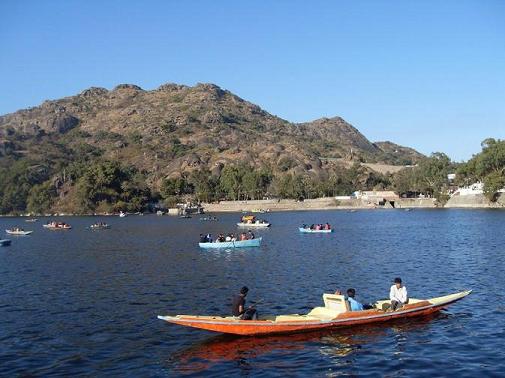 |
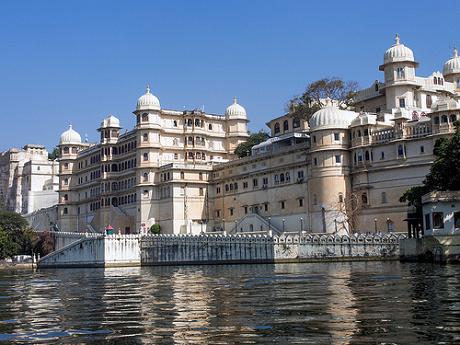 |
|
Nakki
Lake Mountabu |
City
Palace Udaipur |
|
|
|
|
Day 29: Udaipur (Excursion to Nagda)
Today we drive to Nagda and visit some of the temples in Nagda.
Nagda, the ancient Capital of Mewar is situated between Udaipur and
Nathdwara
and located next to the Bagela Lake. This place is dotted with scenic spots and a group of 108 temples. Nagda is situated at the foothills of Eklingji, and is a place of great antiquity. The most important temples in Nagda are the Sas-Bahu temple which is as old as eleventh century. The Jain temple of Adbhutji which was built during the Rana Kumbha’s rule was named so for the strange idol within its shrine. Adbhut means something which is amazing. The nine-foot high odd image in the temple is that of the Jain saint Shanti Nath.
Day 30: Udaipur - Delhi (by air)
In the morning we take a flight to New Delhi. Upon arrival
you will be met by Indo Vacations representative and transferred to the hotel.
In the afternoon we have sightseeing in Old Delhi. Sightseeing of Old Delhi
includes "Rajghat", the place where Mahatma Gandhi was cremated and
Jama Masjid,
the
great mosque of Old Delhi. Today we also visit the famous “Humayun Tomb” which is the first
substantial example of Mughal
architecture
in India and “Qutub Minar” which is 71 meter high and was constructed in 1199. Before
we proceed to the hotel we drive through New Delhi where we visit the
India Gate, Government
buildings and Embassies.
Day 31: Flight to home destination
Around midnight flight to home destination.
Tour
Reservation
To get more information or to book this tour please submit the
Query Form or send us an
e-mail
! Your booking will be activated only after we get a reconfirmation from your
side.
Inclusions:
 Accommodation
in one double room on twin sharing basis with bath and WC
Accommodation
in one double room on twin sharing basis with bath and WC
in the
chosen category.
 American/Continental
Breakfast.
American/Continental
Breakfast.
 Rickshaw ride in
Delhi.
Rickshaw ride in
Delhi.
 Elephant ride in
Amber in Jaipur.
Elephant ride in
Amber in Jaipur.
 Camel Safari in
Bikaner.
Camel Safari in
Bikaner.
 Elephant Safari in
Corbett National Park.
Elephant Safari in
Corbett National Park.
 Boat Ride in
Udaipur.
Boat Ride in
Udaipur.
 Jungle Safari in
Ranthambore, Mount Abu and Kumbhalgarh Wildlife Sanctuary.
Jungle Safari in
Ranthambore, Mount Abu and Kumbhalgarh Wildlife Sanctuary.
 One
Dinner will be with a presentation of Indian music and dance
during your stay in
One
Dinner will be with a presentation of Indian music and dance
during your stay in
Jaipur.
 Services
of qualified local English Speaking or any other language guide
at every
Services
of qualified local English Speaking or any other language guide
at every
city of sightseeing.
 All
Transfers and departures on arrival and departure by Indo
Vacations
All
Transfers and departures on arrival and departure by Indo
Vacations
representative.
 All
Transfers and Sightseeing throughout the tour by an
individual
air-conditioned
All
Transfers and Sightseeing throughout the tour by an
individual
air-conditioned
vehicle (car/Jeep etc.) with driver
(reliable, experienced and English speaking - have
a look at the
references
on our website from all over the world).
Exclusions:
 Any kind of
Personal Expenses such as Tips, Laundry, Telephone Bills, and
Alcoholic
Any kind of
Personal Expenses such as Tips, Laundry, Telephone Bills, and
Alcoholic
beverages.
 Camera Fees
(Still or Movie).
Camera Fees
(Still or Movie).
 Any Flight
Charges.
Any Flight
Charges.
 Monument
Entrances.
Monument
Entrances.
 Unspecified
Meals etc.
Unspecified
Meals etc.
|
We
always look forward for any changes in the itinerary as wished by you for
your individual trip. |
 If
you are willing to travel in a group - the
Group
Departure dates are available
! If
you are willing to travel in a group - the
Group
Departure dates are available
! |
 Check
our
Festival
calendar
to know about the
dates of various festivals of Check
our
Festival
calendar
to know about the
dates of various festivals of
Rajasthan during your
travel ! |
 Visit
Rajasthan
Tours for
more Tours & information on Rajasthan !
Visit
Rajasthan
Tours for
more Tours & information on Rajasthan ! |
 If you are interested in above tour please
e-mail
us with the number of
If you are interested in above tour please
e-mail
us with the number of
participants and the wished
dates to enable us to workout
the tour cost ! |
 Please also check our
FAQ
page to get more
information.
Please also check our
FAQ
page to get more
information.
|
|
|
|
|